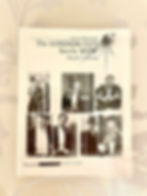A Gentleman's guide to Savile Row splendor - “The London Cut: Savile Row Bespoke Tailoring” by James Sherwood (2007)
- mymoderndarcy
- Oct 29
- 3 min read

Dear readers, I wonder how many of you have been enchanted by the cinematic elegance of “Downton Abbey: The Grand Finale”, the latest chapter in the beloved saga? My curiosity led me to watch it just a month ago, and while the narrative, stellar performances, and evocative settings captivated me, it was the costume design that truly stole the show — particularly the impeccable men’s tailoring. I found myself utterly mesmerized by the portrayal of Noël Coward, brought to life by American-born British actor, Mr. Arty Froushan. Beyond his polished elegance and demeanor, evoking the sophisticated English gentlemen of the 1930s, the tailoring he donned was unquestionably stylish: well-fitted, refined, and whispering of that understated sophistication and timeless class. When it comes to tailoring, especially the quintessentially British variety, Savile Row stands as the ultimate destination for those seeking the pinnacle of sartorial craftsmanship. This storied street, with a heritage spanning over two centuries, has dressed the world’s most distinguished figures, from royalty and aristocracy to celebrated Hollywood icons and high-society gentlemen. It remains the mecca of luxurious bespoke menswear, where tradition meets unparalleled artistry.


Recently, I came across a delightful vintage book through a serendipitous find, titled “The London Cut: Savile Row Bespoke Tailoring” written by the esteemed style journalist and author, Mr. James Sherwood. The wealth of fascinating insights within compelled me to share it with you all today.


Published by Marsilio Editori in 2007, this volume was crafted to coincide with an exhibition of the same name at Pitti Immagine Uomo in January of that year. It celebrated the enduring legacy of Savile Row tailoring, showcasing works from a select group of venerable bespoke houses such as Gieves & Hawkes, Henry Poole & Co., and Huntsman, among others. These historic and legendary pieces reflect the British excellence in the craftsmanship of bespoke clothing, underscoring a steadfast commitment to nurturing this legacy for generations to come.


With forewords by Mr. Raffaello Napoleone, CEO of Pitti Immagine, and Mr. Mark Henderson, the then-Managing Director of Gieves & Hawkes and Chairman of the Savile Row Bespoke Association, this book offers a comprehensive overview of key British bespoke tailoring houses, it spans the historic giants included Gieves & Hawkes, Henry Poole & Co., Dege & Skinner, Norton & Sons, Huntsman, and the like, to the innovative new guard, including Richard James, Edward Sexton, Timothy Everest, Ozwald Boateng, and others. Each house is introduced with its history, signature silhouettes, legendary creations, and the illustrious patrons who have graced their ateliers.


While I also possess another exquisite book by Mr. Sherwood about Savile Row some years ago, this copy is a more compact treasure. Not only does it tie in with the 2007 exhibition, but its portable format makes it an effortless read, allowing one to savor its rich content and exquisite photographs on the go. Through it, one can discover the profound beauty of British sartorial craftsmanship and its deep-rooted connection to Savile Row’s heritage.


Moreover, the author imparts a vital message: the imperative to protect and sustain such intangible cultural treasures. Savile Row has endured centuries of highs and lows, witnessing the evolution of menswear to a point where bespoke tailoring nearly faded into obscurity. Yet, it has reclaimed its spotlight, particularly in recent years, as more discerning gentlemen rediscover its artistry and recognize the vital interplay of men’s style, time-honored techniques, and the essence of British sartorial history. Given that most of these houses are family- or privately owned, preserving this invaluable legacy demands multifaceted support: from securing stable tenancies on the Row to nurturing a talented new generation of bespoke tailors to carry the torch forward. Thus, beyond inspiring those enamored with classic British bespoke tailoring, this book embraces a noble mission: safeguarding a glimpse into this enduring legacy.

I hope this charming little volume continues to inspire you, even more than a decade after its publication, especially if you are passionate about British bespoke menswear and the storied history of Savile Row.
